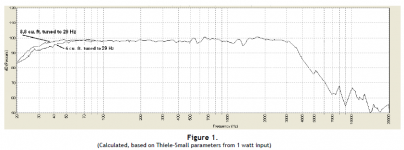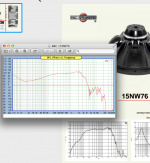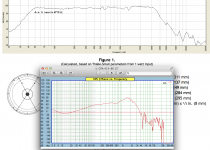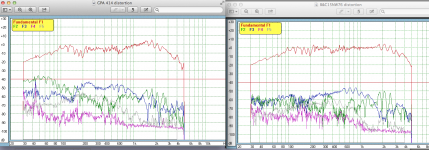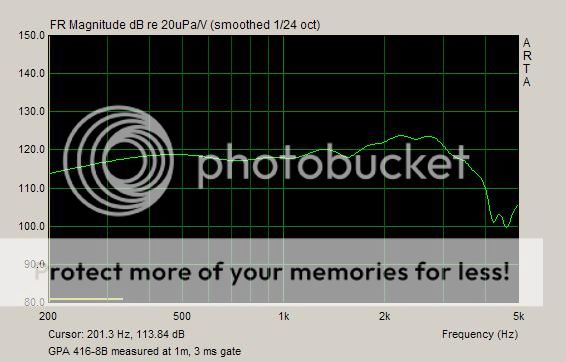It is looking quite likely.
It's always been a toss up between one of the AE drivers (but which one) or only a handful of other drivers to cover (-6dB) between 80 and 320 as a direct radiator sealed box midbass.
To tell the truth, I'd always been secretly barracking for the 416 too :-D
yep, you showed me those before, i was not sure what was that all about, when i look at the specs, it does look good
The increase in efficiency is comparatively small, and equalization would probably throw it away completely
How much is it? EQ would not throw it away for the amplifier and VC, and should be able to compensate any difference in Q (minimum-phase phenomenon)
But I guess if the sensitivity is not much higher then as you say this is just a waste of strength...
shipping is also a matter of concern for us Europeans, making the 416 even more appealing in comparison...one could buy three alnico 416's for the cost of a pair of alnico 515's.
I hope you will be able to post measured T/S, as well as close range frequency response measurements of those two drivers.
I cannot trust the the response curves published by GPA for the 414/416/604, looks like copy/paste in mid band :
http://www.greatplainsaudio.com/downloads/414-8B Spec Sheet.pdf
http://www.greatplainsaudio.com/downloads/416-8B Spec Sheet.pdf
http://www.greatplainsaudio.com/downloads/604E Series II Spec Sheet.pdf
I can understand some form of copy/paste for a given speaker measurement (close range pressure measurement for the lows, and gated 1 or 2m measurement for the mids and highs), but these look too identical among the 3 drivers...
Last edited:
Thanks, Gary.
I guess Bill is going to be busy this year
The only other comparison I'd love to see is the 416 against one of the Beyma woofers some people swear by, i.e. the 12P80Nd and the 15P80Nd, especially in a midbass application like this. I know, the 12P80Nd is of course smaller than the 416/515/TD15M but many say it's truer than its bigger brother, the 15P80Nd, and I can't imagine it not being capable enough for your application (100-700 Hz).
I guess Bill is going to be busy this year
The only other comparison I'd love to see is the 416 against one of the Beyma woofers some people swear by, i.e. the 12P80Nd and the 15P80Nd, especially in a midbass application like this. I know, the 12P80Nd is of course smaller than the 416/515/TD15M but many say it's truer than its bigger brother, the 15P80Nd, and I can't imagine it not being capable enough for your application (100-700 Hz).
The "calculated" simulations GPA uses may be close, but actual measurements (lacking on the GPA site) would be more telling.I cannot trust the the response curves published by GPA for the 414/416/604, looks like copy/paste in mid band...these look too identical among the 3 drivers...
Someday, someone somewhere might actually measure and post the response of a GPA speaker.
Art
Attachments
I was told "Don't worry about the measurements, just listen to them".
Which, of course, you would do.
Me, I'd look at the measurements and just move on.
Indeed, I did miss the legend.The "calculated" simulations GPA uses may be close, but actual measurements (lacking on the GPA site) would be more telling.
How can they simulate such midband aberrations using T/S parameters?
Attachments
Gary's preliminary measurements indicate a Qts of 0.26 for both 416 Alnico's, and a Qts of 0.2 for both 515 Alnico's. The 515 Alnico is 1.5 dB more efficient than the 416 Alnico, after correcting for the 416 being an 8-ohm driver and the 515 a 16-ohm driver (both drivers can be ordered in 8 and 16-ohm formats).
I should emphasize these preliminary measurements, but Gary used both TD15M's as a cross-check, and got results within a few percent of the published AE figures.
Sidebar: For people who own tube amps, the driver impedance is largely irrelevant, since there's a selection of 4, 8, and 16-ohm taps on the output transformer, and vacuum-tube amps do not need current-limiting protection circuits. In terms of the power envelope the amplifier can deliver, vacuum tubes can be thought of as constant-power devices that self-limit in voltage and current domains. To repeat, the Beyond the Ariel project is only for people who own Class A direct-heated triode amplifiers with power outputs in the 3 to 20-watt range. Owners of Class AB transistor amplifiers have a very wide variety of loudspeaker choices.
I should emphasize these preliminary measurements, but Gary used both TD15M's as a cross-check, and got results within a few percent of the published AE figures.
Sidebar: For people who own tube amps, the driver impedance is largely irrelevant, since there's a selection of 4, 8, and 16-ohm taps on the output transformer, and vacuum-tube amps do not need current-limiting protection circuits. In terms of the power envelope the amplifier can deliver, vacuum tubes can be thought of as constant-power devices that self-limit in voltage and current domains. To repeat, the Beyond the Ariel project is only for people who own Class A direct-heated triode amplifiers with power outputs in the 3 to 20-watt range. Owners of Class AB transistor amplifiers have a very wide variety of loudspeaker choices.
Last edited:
Indeed, I did miss the legend.
How can they simulate such midband aberrations using T/S parameters?
He can't that's why his simulations and reality differ so greatly.
Thanks for the link. This must be the first GPA measurement plot I've seen.
It seems to be a little 'rich' in nonlinear distortion. What worries me is the dominant odd order distortion in 200Hz - 1kHz range.
.
Originally Posted by pos
Indeed, I did miss the legend.
How can they simulate such midband aberrations using T/S parameters?
Makes one wonder what the GPA 416/515 upper peak looks/sounds like.
Art
Indeed, I did miss the legend.
How can they simulate such midband aberrations using T/S parameters?
Yes, it is interesting to see how close Wippersnapper's measurements for upper response (his test protocol is not accurate below around 200 Hz) for the B&C NW15NW76 matches B&C's measurements, while GPA's 414-8B 12" simulation does not include the 7 dB (or so) peak around 1600 Hz.He can't that's why his simulations and reality differ so greatly.
Makes one wonder what the GPA 416/515 upper peak looks/sounds like.
Art
Attachments
With distortion at -40 dB, around 1% at 19 volts (around 45 watts) the GPA 414 distortion does not make me worry.Thanks for the link. This must be the first GPA measurement plot I've seen.
It seems to be a little 'rich' in nonlinear distortion. What worries me is the dominant odd order distortion in 200Hz - 1kHz range.
The B&C 15NW76 distortion at -50 dB is about .3%, but the upper F3 and F5 distortion looks similar in content.
Attachments
I would like to find driver which has clearly dominating 2nd order distortion. Not particularly high in absolut level, but 2nd order should be the highest.
Like this driver here:
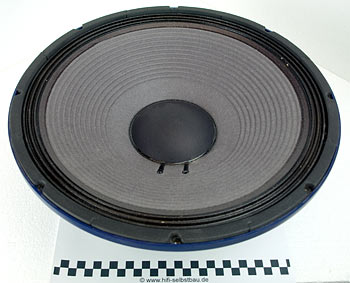
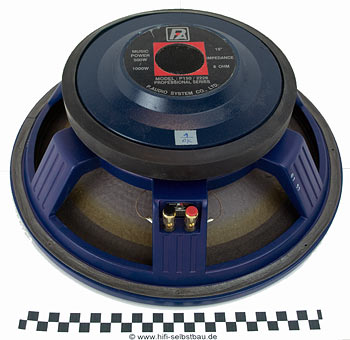
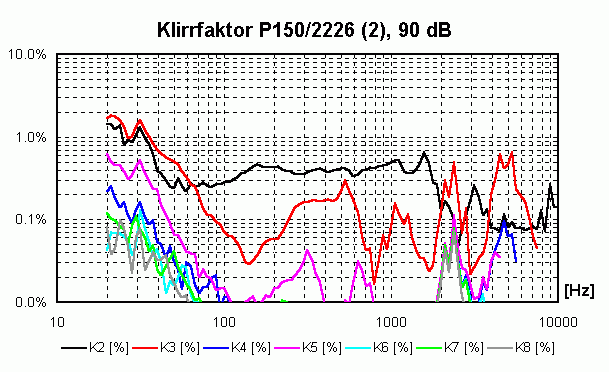
Pics from here:
'http://www.hifi-selbstbau.de/index.php?option=com_content&view=article&id=323'
.
Like this driver here:



Pics from here:
'http://www.hifi-selbstbau.de/index.php?option=com_content&view=article&id=323'
.
Which, of course, just goes to show how little you know me.Which, of course, you would do.

The problem was - I had measured.
Someday, someone somewhere might actually measure and post the response of a GPA speaker.
I pondered that very thought while planning the recent modifications. Spent a lot of time googling, but couldn't find anything useful. Decided to take the plunge anyway.
I'll see what I can do.
Gary Dahl
- Home
- Loudspeakers
- Multi-Way
- Beyond the Ariel

